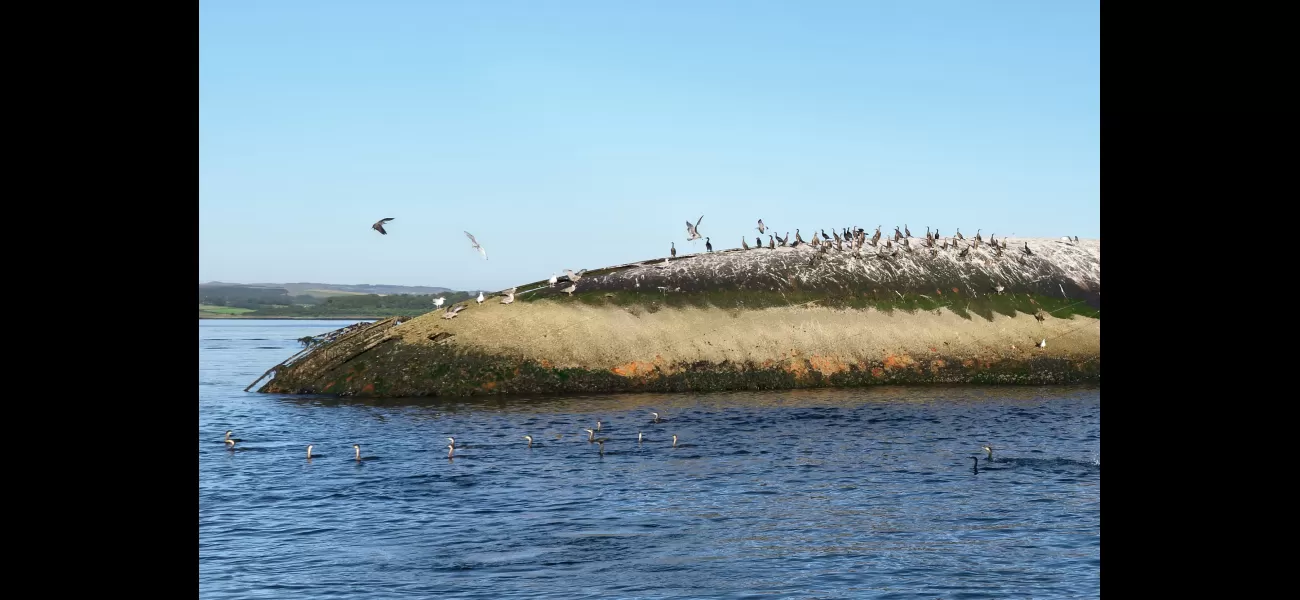For 50 years, a shipwreck has been abandoned and decaying on the UK coast, shrouded in mystery.
It was reminiscent of Robinson Crusoe, with its vast expanse resembling an island.
March 19th 2024.

It's been half a century since the MV Captayannis, a Greek sugar ship, sank on January 27, 1974, off the coast of Glasgow, Scotland. The ship capsized after strong winds of 60mph caused it to flood and keel over, leaving it stranded on a sandbank in the Firth of Clyde. Despite becoming a popular tourist attraction, many people still wonder why the wreck has been left untouched for so long.
As it turns out, the reason behind the wreck's preservation lies in a long-running legal dispute between the ship's owners and insurers. Plans to blow up the vessel never came to fruition, leaving it to slowly rust and decay over the years. The MV Captayannis had been waiting to unload its cargo of raw sugar for the Tate & Lyle factory in Greenock, which is why it is now known as the "sugar ship."
When the captain, Theodorakis Ionnis, attempted to restart the engines, the pump rooms were already flooded due to the sudden gales. The ship began to drift and eventually collided with the anchor chains of a BP tanker, the British Light, tearing a hole in its hull below the waterline. Luckily, all 30 crew members were rescued without any injuries. In the years following the wreck, it has become a sanctuary for sea birds and fish, but it poses no threat to navigation as it sticks out of the water.
Former Provost Billy Petrie recalls discussions about the wreck during his time in the council, but no one took responsibility for its removal. The Clyde Navigation Trust confirmed that it was not a navigational hazard, but the issue remained unresolved between the owners and insurers. If the wreck had been in a more heavily trafficked area, it would have been removed long ago.
Despite being looted and stripped of most of its valuable contents, the MV Captayannis still stands as a steel hull and superstructure. Its deck remains surprisingly intact, and it has become a haven for nature. Schools of fish now swim around the wreckage, and sea birds have made their nests in its empty hatches. However, the BBC reports that the smell of bird droppings can be overwhelming for anyone who gets close enough to the wreck.
In the past, there were plans to blow up the wreck, but they were abandoned due to its close proximity to the Ardmore Point bird sanctuary. This means that the MV Captayannis will continue to be a part of the Firth of Clyde for the foreseeable future, attracting curious visitors and sparking discussions about its history and preservation.
As it turns out, the reason behind the wreck's preservation lies in a long-running legal dispute between the ship's owners and insurers. Plans to blow up the vessel never came to fruition, leaving it to slowly rust and decay over the years. The MV Captayannis had been waiting to unload its cargo of raw sugar for the Tate & Lyle factory in Greenock, which is why it is now known as the "sugar ship."
When the captain, Theodorakis Ionnis, attempted to restart the engines, the pump rooms were already flooded due to the sudden gales. The ship began to drift and eventually collided with the anchor chains of a BP tanker, the British Light, tearing a hole in its hull below the waterline. Luckily, all 30 crew members were rescued without any injuries. In the years following the wreck, it has become a sanctuary for sea birds and fish, but it poses no threat to navigation as it sticks out of the water.
Former Provost Billy Petrie recalls discussions about the wreck during his time in the council, but no one took responsibility for its removal. The Clyde Navigation Trust confirmed that it was not a navigational hazard, but the issue remained unresolved between the owners and insurers. If the wreck had been in a more heavily trafficked area, it would have been removed long ago.
Despite being looted and stripped of most of its valuable contents, the MV Captayannis still stands as a steel hull and superstructure. Its deck remains surprisingly intact, and it has become a haven for nature. Schools of fish now swim around the wreckage, and sea birds have made their nests in its empty hatches. However, the BBC reports that the smell of bird droppings can be overwhelming for anyone who gets close enough to the wreck.
In the past, there were plans to blow up the wreck, but they were abandoned due to its close proximity to the Ardmore Point bird sanctuary. This means that the MV Captayannis will continue to be a part of the Firth of Clyde for the foreseeable future, attracting curious visitors and sparking discussions about its history and preservation.
[This article has been trending online recently and has been generated with AI. Your feed is customized.]
[Generative AI is experimental.]
0
0
Submit Comment





